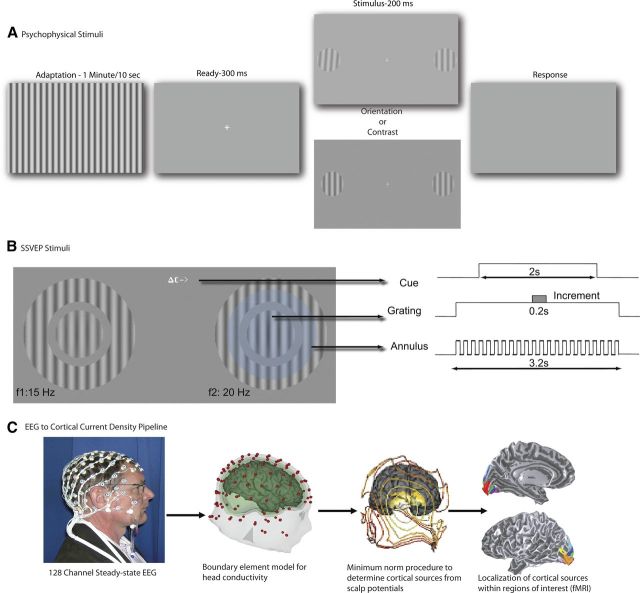Figure 2.
Stimuli and methods. A, Psychophysics. Observers adapted to a full field grating (for 1 min on the first trial and for 10 s on subsequent trials) whose orientation was fixed at 0, 10, 20, 30, or 40 ° from the vertical test. Orientation and contrast increment thresholds were measured in separate blocks. The adaptor had a contrast of 90% and flickered on and off at 5 Hz. After the adaptation period, two near-vertical targets appeared 5° to the left and right of fixation. The targets were 2° in diameter and had a base contrast of 50% and a spatial frequency of 2 c/deg. They were presented for 200 ms after the offset of the adaptor. B, Steady-state EEG. Observes fixated a marker at the center of the screen. A cue indicating the task and the location of the increment was presented at fixation (here a contrast modulation task is indicated). Stimuli appeared in the lower visual field, 1.5° below and 4.5° to the left and right of fixation. The static target grating was surrounded by a “reporter” annulus with the same spatial frequency. The contrast of the reporter grating modulated on and off in a square wave at 15 and 20 Hz on the left and right, respectively, and generated unique frequency-tagged responses in the SSVEP. The faint blue circle (not part of stimulus) depicts the observer's attentional window over the target and shows attention spilling over onto the flickering annulus on the cued side. The contrasts of the reporter gratings were set at 75 and 83%, respectively, so they appeared perceptually matched in contrast and generated EEG responses of approximately equal amplitude. Each trial lasted 2 s and started with the appearance of the cue at the fixation point indicating the task (contrast or orientation discrimination) and the location (left or right) of the increment. The target and grating stimuli came on 600 ms before the start of the trial to eliminate onset transients. C, Pipeline to convert SSVEP to cortical current density data.

